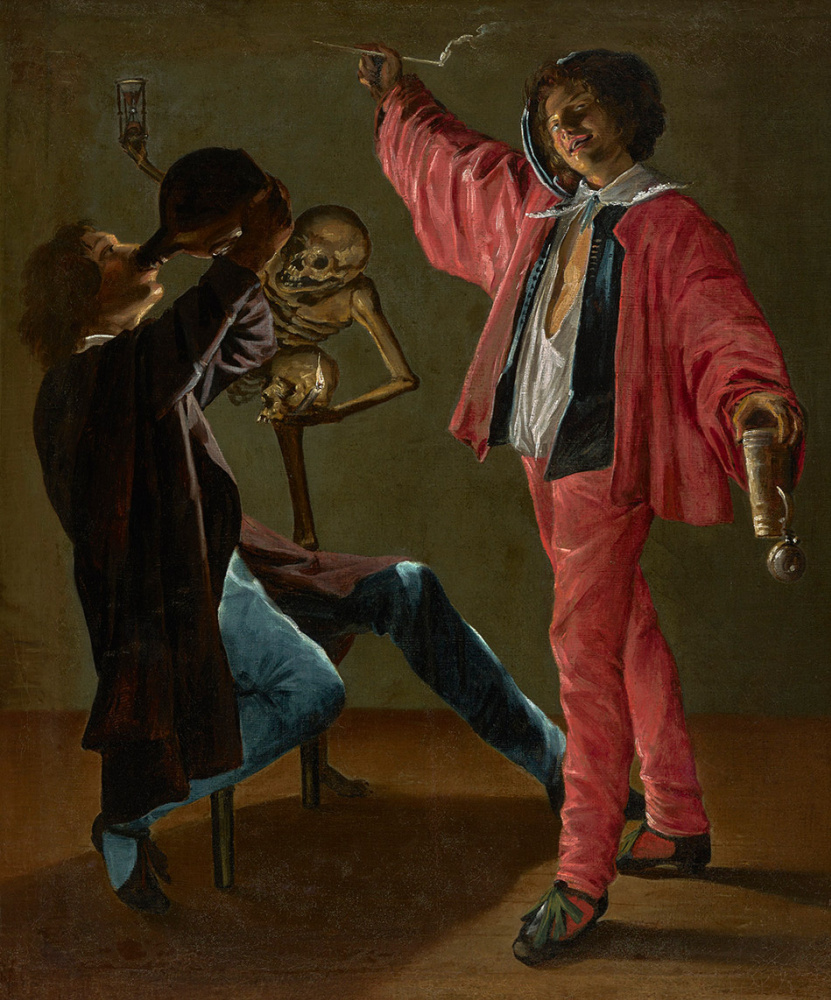log in
Enter site
Login to use Arthive functionality to the maximum
The Last Drop (The Gay Cavalier)
Judith Leyster • Painting, 1639, 89.2×73.6 cm
Description of the artwork «The Last Drop (The Gay Cavalier)»
The Last Drop is the name of the painting of Judith Leyster, a Harlem artist, presumably a student and, for sure, a good friend of the great Frans Hals. This woman was one of the few ladies who were accepted into the St. Luke workshop, she was married to a Hals’s student (much less talented than his wife), was present at the christening of one of the youngest children of Hals and sued him because of a departed student. Moreover, she also painted pictures in the style of Hals, copying his swift, light manner so convincingly that her artwork was more than once attributed to Frans himself.
Despite the cheerful faces of revellers, the subtext of the picture is rather gloomy. This is undoubtedly a vanitas, a picture with vanity. It reminds the viewer that no matter how rich, healthy, blush, cheerful you are, the cup of your life (in this case, the jug and the mug) will inevitably dry up, the pipe — a sign of vain entertainment — will go out, the torch illuminating your holiday will burn out, and the last grains of life will pour into the lower half of the hourglass. And that’s all, sinner: the end of your joys, and the end of your life, and therefore repent before it’s too late.
In vanitas still lifes, death was usually indicated by a skull grinning now from a pile of books (you are a scientist and you will die), then from under a polished helmet (you are a soldier and you will die). The skull could have its place near a half-empty glass, pearl threads, scrolls with notes, a wallet with coins, a bunch of keys: you eat and drink, write notes and bills, own a house and vain luxury — and you will die... In this quite realistic scene, Judith Leyster did not restrict herself with the skull, but introduced death into the composition, as a completely living subject. Like a disgruntled neighbour old man, he shakes an hourglass in front of drunken youths. It seems that in a second he will utter squeakily: “Young people, have you looked at the clock? Another minute, and I’ll call the city police!”
Probably, at some point, such a neighbourhood seemed to reduce the attractiveness of the picture, and the unfortunate skeleton was overpainted, so that only an unconvincing candlestick was left. Fortunately, when preparing the canvas for a relatively recent exhibition in Philadelphia, it was decided to clean it up, and the harmless party acquired the bitter, ashy taste of vanitas again.
Author: Oksana Sanzharova
Despite the cheerful faces of revellers, the subtext of the picture is rather gloomy. This is undoubtedly a vanitas, a picture with vanity. It reminds the viewer that no matter how rich, healthy, blush, cheerful you are, the cup of your life (in this case, the jug and the mug) will inevitably dry up, the pipe — a sign of vain entertainment — will go out, the torch illuminating your holiday will burn out, and the last grains of life will pour into the lower half of the hourglass. And that’s all, sinner: the end of your joys, and the end of your life, and therefore repent before it’s too late.
In vanitas still lifes, death was usually indicated by a skull grinning now from a pile of books (you are a scientist and you will die), then from under a polished helmet (you are a soldier and you will die). The skull could have its place near a half-empty glass, pearl threads, scrolls with notes, a wallet with coins, a bunch of keys: you eat and drink, write notes and bills, own a house and vain luxury — and you will die... In this quite realistic scene, Judith Leyster did not restrict herself with the skull, but introduced death into the composition, as a completely living subject. Like a disgruntled neighbour old man, he shakes an hourglass in front of drunken youths. It seems that in a second he will utter squeakily: “Young people, have you looked at the clock? Another minute, and I’ll call the city police!”
Probably, at some point, such a neighbourhood seemed to reduce the attractiveness of the picture, and the unfortunate skeleton was overpainted, so that only an unconvincing candlestick was left. Fortunately, when preparing the canvas for a relatively recent exhibition in Philadelphia, it was decided to clean it up, and the harmless party acquired the bitter, ashy taste of vanitas again.
Author: Oksana Sanzharova


